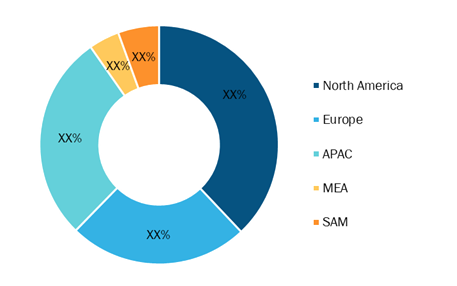The indoor flooring market size is expected to reach US$ 210.66 billion by 2028, registering at a CAGR of 4.9% during the forecast period of 2021 to 2028, according to a new research study conducted by The Insight Partners.
Rise in Number of Commercial and Residential Construction Projects to Provide Growth Opportunities for Indoor Flooring Market
Home renovation and remodeling activities are increasing in many countries, which can be mainly attributed to growing government support for the same, especially in the developed countries. For instance, in Europe, the National Energy Efficiency Action Plan aims to foster investments in the repair and remodeling of residential and commercial buildings. Moreover, according to the Leading Indicator of Remodeling Activity by the Remodeling Futures Program, repair and renovation spending in the US is expected to increase from 6% in the first quarter of 2018 to 6.3% by the end of the second quarter of 2018.
The willingness to spend substantial amounts on the styling of living spaces has attracted the focus of consumers toward home furnishings such as carpets and rugs that enhance the aesthetic appeal of interiors. This shift is supported by the rise in consumer income levels, changes in lifestyles, and adoption of different cultures in terms of interior decor. Floor coatings such as ceramic tiles, carpets, vinyl, and linoleum, as well as rubber, wood, and laminate are applied on surfaces to impart slip resistance properties to them. Besides offering slip resistance, they provide anti-vibration, antistatic, and waterproof properties. Coatings such as epoxy coatings increase the durability of concrete floors. Epoxy, polyurethane, and acrylic coating on concrete floors make them capable of withstanding a considerable amount of static and dynamic loads. Floor coatings also prevent wear and tear on the surface of these floors. As floor coatings are resistant to cleansers, oils, chlorides, water, snow, ice, hail, transmission fluids, and bleaches, they are increasingly being used to overlay the floors of parking spaces, garages, and car showrooms. Moreover, they are used to enhance the aesthetics of floors in houses. Metallic pigments are added to the indoor flooring materials to create a metallic swirl effect. Further, there is a growing trend of adding vinyl color flakes and metallic pigments to add a rich color layer and texture to the floor surface. Thus, the above-mentioned factors are likely to boost the growth of market.
Asia-Pacific dominated the Indoor Flooring market, followed by North America and Europe. The dominance of Asia-Pacific is majorly attributed to the continuous emphasis on the clean environment by the governments. The global indoor flooring market has been segmented based on type and end user. Based on type, the indoor flooring market is categorized into ceramic tiles, carpet, vinyl linoleum & rubber, wood & laminate, and others . The ceramic tiles segment dominated the indoor flooring market in 2020. Based on end user, the indoor flooring market is segmented into residential and non-residential. The residential segment led the indoor flooring market in 2020.
Impact of COVID-19 Pandemic on Indoor Flooring Market
The COVID-19 outbreak has significantly impacted infrastructure development and the global economy. International response to the rapid disruption to key infrastructure sectors and industries is ongoing. According to the latest situation report from World Health Organization, the US, India, Brazil, Russia, the UK, France, Spain, and Italy are among the worst affected countries due to the COVID-19 outbreak. The outbreak first began in Wuhan (China) in December 2019, and since then, it has spread across the globe. The COVID-19 crisis has affected the industries worldwide. The global economy was adversely affected in 2020, which is likely to continue in 2021. The pandemic has disturbed indoor flooring businesses and suppliers around the globe. Market players experienced disruptions in their operations, and they are likely to face consequences till mid-2021. The factory shutdowns, trade bans, and border lockdowns have adversely affected the indoor flooring industry. On the flipper side, the market is opening in 2021 so it expected to gain traction in the near future.
Forbo International SA; Mats Inc.; Tarkett; Armstrong Flooring, Inc.; Beaulieu International Group; Ecore International, Interface, Inc.; Toli Corporation; Mohawk Industries, Inc.; and Shaw Industries Group, Inc. are among the few major companies operating in the indoor flooring market.
Indoor Flooring Market — by Geography, 2020

Indoor Flooring Market Insights Report | Size, Share, Scope 2028
Download Free Sample
Indoor Flooring Market Forecast to 2028 - COVID-19 Impact and Global Analysis By Type (Ceramic Tiles, Carpet, Vinyl Linoleum & Rubber, Wood & Laminate, and Others) and End user (Residential and Non-Residential)
Indoor Flooring Market Insights Report | Size, Share, Scope 2028
Download Free SampleIndoor Flooring Market Forecast to 2028 - COVID-19 Impact and Global Analysis By Type (Ceramic Tiles, Carpet, Vinyl Linoleum & Rubber, Wood & Laminate, and Others) and End user (Residential and Non-Residential)
The global indoor flooring market has been segmented as follows:
Global Indoor Flooring Market – by Type
- Ceramic Tiles
- Carpet
- Vinyl Linoleum & Rubber
- Wood & Laminate
- Others
Global Indoor Flooring Market – by End User
- Residential
- Non-Residential
Global Indoor Flooring Market – by Geography
- North America
- US
- Canada
- Mexico
- Europe
- France
- Germany
- Italy
- Russia
- UK
- Rest of Europe
- Asia-Pacific (APAC)
- China
- India
- Japan
- Australia
- South Korea
- Rest of APAC
- Middle East & Africa (MEA)
- Saudi Arabia
- UAE
- South Africa
- Rest of MEA
- South & Central America (SCAM)
- Brazil
- Argentina
- Rest of SCAM
Contact Us
Phone: +1-646-491-9876
Email Id: sales@theinsightpartners.com